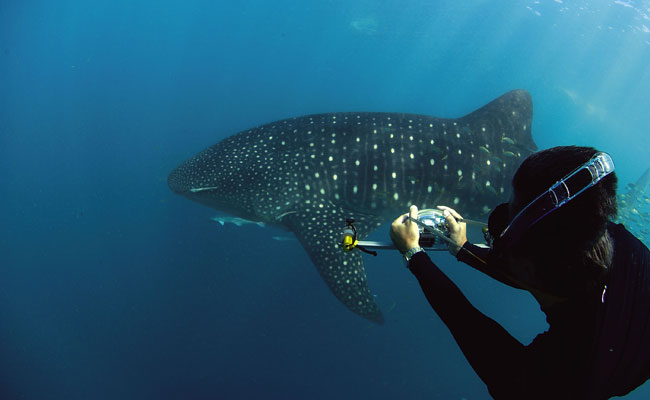Whale Sharks Thrive in Australian Waters

Whale sharks, which grow to weigh as much as two or three adult elephants, are thriving in waters off Western Australia, a new study of underwater images suggests.
Up to 65 feet long (20 meters), the whale shark, Rhincodon typus, is the world's largest living fish species — and also the largest shark. Though hefty, this shark is known as the "gentle giant" for its non-predatory behavior. Rather than tearing through meaty flesh of prey like many sharks, this fish, with its broad, flattened head and tiny teeth inside a giant mouth, eats tiny zooplankton, sieving them through a fine mesh of gill-rakers.
Relatively little is known about the health and migratory behaviors of whale sharks, which live in tropical and warm seas, including the western Atlantic and southern Pacific.
The new research combines computer-assisted photographic identification with data collected by ecotourists, among others, and suggests whale shark populations in Ningaloo, Western Australia, are healthy, although research at other locations, such as South Africa and Thailand, has reported declines in population size.
Swimming with sharks
West Australian marine scientist Brad Norman of ECOCEAN, a marine conservation organization, and Murdoch University in Australia began the study in 1995.
Swimming alongside each whale shark in the Ningaloo Reef, the researchers photographed or video-taped the white lines and spots along the flanks of the animal. Like a human fingerprint, the patterns of speckles and stripes on the skins of whale sharks are thought to be unique to each individual.
Sign up for the Live Science daily newsletter now
Get the world’s most fascinating discoveries delivered straight to your inbox.
To make sense of the images, Norman teamed up with ECOCEAN computer programmer Jason Holmberg and astronomer Zaven Arzoumanian of NASA's Goddard Space Flight Center in Greenbelt, Md., who adapted software originally used with the Hubble space telescope. The pattern-recognition software developed by Holmberg and Arzoumanian allowed the group to positively identify individual whale sharks.
Based on 5,100 underwater images of 355 whale sharks contributed by hundreds of researchers, divers and ecotourists, Norman, Holmberg and Arzoumanian obtained almost 10 times more data than any previous study.
“To study whale sharks in a meaningful way, we really had to rethink how we collect data and how we analyze it,” Holmberg said. “The results surpassed our expectations, allowing hundreds of individuals to contribute and providing the necessary data to obtain a closer look at the population’s health.”
Reef management
Ningaloo Reef is one of the best locations to find whale sharks, especially between April and June. The researchers found that more whale sharks are returning to the northern area of Ningaloo Marine Park from season to season, suggesting the population is growing. They found that about two-thirds of the sharks were repeat visitors, while one-third were sighted only once during the study period.
As a rare and highly migratory fish, whale sharks are a big draw for Ningaloo’s ecotourism industry, where tourists pay to get close views and even swim with the sharks. In spite of their gargantuan size, whale sharks are fairly docile; the main risk to humans comes from getting in the way of their very large and powerful tails.
The authors say their study, published in the Ecological Society of America’s January issue of the journal Ecological Applications, suggests that the management guidelines for whale shark ecotourism at Ningaloo appear to be on target.
“Applying these guidelines to other locations along whale shark migration routes may offer a viable alternative to hunting these fish, one that yields both economic and conservation benefits,” Norman said.
Norman and colleagues note that while their study is encouraging for the Ningaloo whale shark populations, global concern over their future is justified, especially in areas where the sharks continue to be hunted for their fins and meat. The researchers hope others will apply their techniques to other whale shark populations, as well as to other species.
- Video: Swimming with Whale Sharks
- Image Gallery: Great White Sharks
- Vote for Your Favorite Shark










